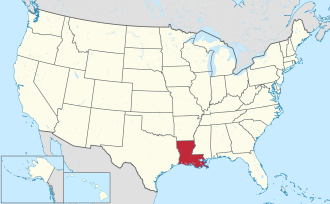Catahoula Parish | |
|---|---|
 Historic Marker Signs at Ferry Place and Peck Mounds. | |
 Location within the U.S. state of Louisiana | |
 Louisiana's location within the U.S. | |
| Coordinates: 31°40′N91°51′W / 31.67°N 91.85°W | |
| Country | |
| State | |
| Founded | March 23, 1808 |
| Named after | Tensas word for big, clear lake |
| Seat | Harrisonburg |
| Largest town | Jonesville |
| Area | |
• Total | 739 sq mi (1,910 km2) |
| • Land | 708 sq mi (1,830 km2) |
| • Water | 31 sq mi (80 km2) 4.2% |
| Population (2020) | |
• Total | 8,906 |
| • Density | 12/sq mi (4.7/km2) |
| Time zone | UTC−6 (Central) |
| • Summer (DST) | UTC−5 (CDT) |
| Congressional district | 5th |
| Website | www |
Catahoula Parish (French : Paroisse de Catahoula) is a parish in the U.S. state of Louisiana. As of the 2020 census, the population was 8,906. [1] Its seat is Harrisonburg, [2] on the Ouachita River. The parish was formed in 1808, shortly after the United States acquired this territory in the Louisiana Purchase of 1803. [3]

